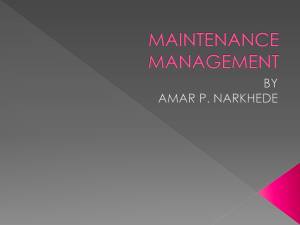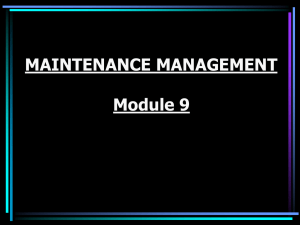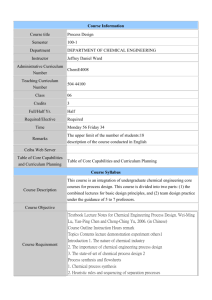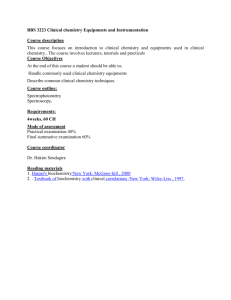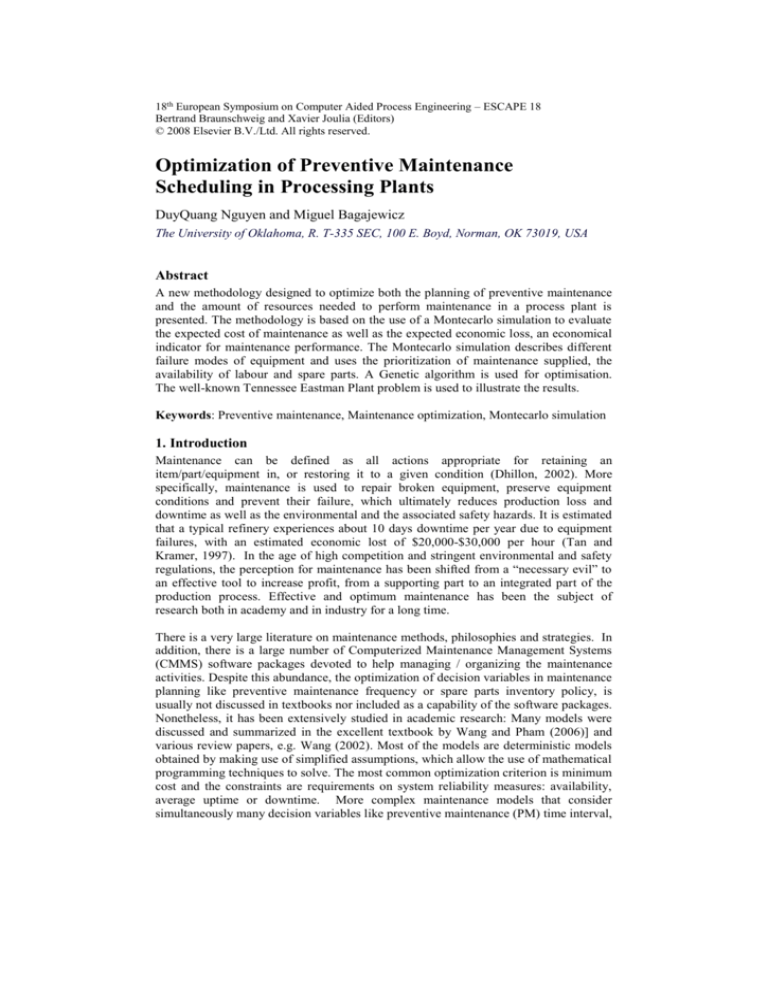
18th European Symposium on Computer Aided Process Engineering – ESCAPE 18
Bertrand Braunschweig and Xavier Joulia (Editors)
© 2008 Elsevier B.V./Ltd. All rights reserved.
Optimization of Preventive Maintenance
Scheduling in Processing Plants
DuyQuang Nguyen and Miguel Bagajewicz
The University of Oklahoma, R. T-335 SEC, 100 E. Boyd, Norman, OK 73019, USA
Abstract
A new methodology designed to optimize both the planning of preventive maintenance
and the amount of resources needed to perform maintenance in a process plant is
presented. The methodology is based on the use of a Montecarlo simulation to evaluate
the expected cost of maintenance as well as the expected economic loss, an economical
indicator for maintenance performance. The Montecarlo simulation describes different
failure modes of equipment and uses the prioritization of maintenance supplied, the
availability of labour and spare parts. A Genetic algorithm is used for optimisation.
The well-known Tennessee Eastman Plant problem is used to illustrate the results.
Keywords: Preventive maintenance, Maintenance optimization, Montecarlo simulation
1. Introduction
Maintenance can be defined as all actions appropriate for retaining an
item/part/equipment in, or restoring it to a given condition (Dhillon, 2002). More
specifically, maintenance is used to repair broken equipment, preserve equipment
conditions and prevent their failure, which ultimately reduces production loss and
downtime as well as the environmental and the associated safety hazards. It is estimated
that a typical refinery experiences about 10 days downtime per year due to equipment
failures, with an estimated economic lost of $20,000-$30,000 per hour (Tan and
Kramer, 1997). In the age of high competition and stringent environmental and safety
regulations, the perception for maintenance has been shifted from a “necessary evil” to
an effective tool to increase profit, from a supporting part to an integrated part of the
production process. Effective and optimum maintenance has been the subject of
research both in academy and in industry for a long time.
There is a very large literature on maintenance methods, philosophies and strategies. In
addition, there is a large number of Computerized Maintenance Management Systems
(CMMS) software packages devoted to help managing / organizing the maintenance
activities. Despite this abundance, the optimization of decision variables in maintenance
planning like preventive maintenance frequency or spare parts inventory policy, is
usually not discussed in textbooks nor included as a capability of the software packages.
Nonetheless, it has been extensively studied in academic research: Many models were
discussed and summarized in the excellent textbook by Wang and Pham (2006)] and
various review papers, e.g. Wang (2002). Most of the models are deterministic models
obtained by making use of simplified assumptions, which allow the use of mathematical
programming techniques to solve. The most common optimization criterion is minimum
cost and the constraints are requirements on system reliability measures: availability,
average uptime or downtime. More complex maintenance models that consider
simultaneously many decision variables like preventive maintenance (PM) time interval,
2
Nguyen & Bagajewicz
labor workforce size, resources allocation are usually solved by Genetic algorithm (e.g.
Sum and Gong, 2006; Saranga, 2004). Monte Carlo simulation is usually used to
estimate reliability parameters in the model. Tan and Kramer (1997) utilized both
Monte Carlo simulation and GA.
None of preventive maintenance planning models considers constraints on resources
available in process plants, which include labor and materials (spare parts). For
example, the maintenance work force, which is usually limited, cannot perform
scheduled PM tasks for some equipments at scheduled PM time because of the need to
repair other failed equipments. Such dynamic situations can not be handled by
deterministic maintenance planning models or are not considered in published
maintenance planning models that use Monte Carlo simulation tools.
To ameliorate all the aforementioned shortcomings, we developed a new maintenance
model based on the use of Monte Carlo simulation. The model incorporates three
practical issues that have not been considered in previous work: i) different failure
modes of equipment, ii) ranking of equipments according to the consequences of failure,
iii) labor resource constraints and material resource constraints. The maintenance
model, which was developed by Nguyen et al. (2008) is integrated here with a GA
optimization to optimize the PM frequency.
2. Monte Carlo simulation – based maintenance model
2.1. The objective value
The objective value is the total maintenance cost plus economic loss (to be minimized).
The economic loss is the loss caused by equipment failures that lead to reduced
production rate or downtime. It is the economic indicator for maintenance performance,
i.e. the better the maintenance plan the smaller the economic loss. Thus by minimizing
the maintenance cost plus the economic loss, one simultaneously optimizes the cost and
the performance of maintenance.
The cost term includes four types of cost: the PM cost and CM cost, which are the costs
associated with preventive maintenance and corrective maintenance activities,
respectively, the Labor cost (the salary paid to employees) and the inventory cost (the
cost associated with storing spare parts of equipments).
The economic loss term includes two types of losses: i) economic loss associated with
failed equipments that have not been repaired (for example, a fouled heat exchanger can
continue operating but at reduced heat transfer rate, ii) economic loss due to
unavailability of equipment during repair time. The economic loss is calculated as a loss
rate ($ per day) multiplied by the duration of the period within which the loss is
realized. To determine economic loss rates, an analysis is carried out on each piece of
equipment to determine the economical effects of equipment failure, which include
reduced production rate or even shutdown, the deterioration of product quality, etc.
2.2. Input data
The following data are needed in the model: i) reliability data for equipment, ii) the time
and the associated material cost to perform corrective maintenance (CM) and preventive
maintenance, iii) economic data: labor paid rate, inventory cost rate and economic loss
rate, iv) other data like the waiting time for an emergently ordered spare part to arrive.
Optimization of Preventive Maintenance Scheduling in Processing Plants
We assume that the failure distribution is exponential, thus, only one parameter is
needed to describe the reliability of equipment: the mean time between failures
(MTBF). Other distributions can be used but they require at least two parameters.
2.3. Ranking of repairs
The equipments to be repaired are ranked according to the consequences of failures: 1 is
emergent and 5 is affordable to go unrepaired. The maintenance of equipments with
higher rank (higher priority) takes precedence over the lower ranked ones (Table 1).
Table 1: Ranking of equipments for Maintenance purpose (following Tischuk, 2002)
Consequence of Failure
Probability of subsequent
catastrophic Failure
High
Medium
Low
High
1
2
3
Medium
2
3
4
Low
3
4
5
2.4. Failure modes of equipments
An equipment may have different failure modes involving different parts of the
equipment. It can fail because of deterioration of mechanic parts (possible consequence
is complete failure that requires equipment replacement) or electronic parts malfunction
(partial failure that can be repaired). Different failure modes need different repair costs
and repair times and induce different economic losses. The sampling of different failure
modes of equipment is done as follows: i) assign a probability of occurrence for each
type of failure mode using information on how common a failure mode is, ii) at the
simulated failure time of the equipment, the type of failure mode that actually occurred
is sampled in accordance with the failure modes’ probability of occurrence.
2.5. Decision variables
Three decision variables are considered in the model: i) the PM time schedule that
involves two parameters: the time to perform the first PM (called PM starting time) and
the PM time interval, ii) the inventory policy, which is the decision whether to keep
inventory for a specific spare part necessary for repairing a specific equipment, iii) the
number of maintenance employees. The PM starting time and PM time interval are
expressed as a fraction of MTBF (e.g. PM time interval = a*MTBF), the fraction a is to
be optimized (for each equipment).
3. Monte Carlo simulation procedure
Most of the material in this section is taken from a recent paper (Nguyen et al, 2008)
that has explored the use of Monte Carlo simulation for evaluation purposes.
3.1. Maintenance rules
- No delay in performing maintenance once the resources are available
- If equipment has undergone corrective maintenance a predetermined period of
time prior to the scheduled PM (current value = 7 days), the PM is suspended
so that resources can be used elsewhere
3
4
Nguyen & Bagajewicz
-
If, due to unavailability of resources, repair of an equipment has been delayed
more than a predetermined threshold value (current value = 21 days), the
priority for repair of that equipment is upgraded one level
3.2. Simulation details
This technique is based on repeated sampling of the equipment failure and evaluation of
the cost of maintenance activities as well as the economic losses associated to the failed
states of equipments. The method continues sampling and computing an average until
the average converges to a finite value.
The sampling procedure is as follows:
-
-
-
Failure times of equipments are sampled using reliability function (failure rate)
of equipments
At failure times of equipment, the type of failure modes that caused equipment
failure is sampled in accordance with the probability of occurrence.
The cost of corrective maintenance, the repair time and the economic losses are
determined corresponding to the type of failure modes identified.
Preventive maintenance requests for equipments are generated in accordance
with the predetermined preventive maintenance schedule (predetermined PM
policy)
The planning time horizon is divided into time intervals of weeks.
In each week:
i) All the CM requests (when equipments failed) and all the scheduled
PM requests are identified.
ii) CM request and PM requests for equipment with highest priority will
be fulfilled. Continuing with CM requests and PM requests for
equipments with lower priority until the (labor and materials)
resource available is used up. If resources are not available, the
requested maintenance action has to be delayed until the resources
become available again (e.g. the needed spare part is available
through emergent purchasing).
When a maintenance action is performed on an equipment at time t, that
equipment is assumed to be as good as brand new and failure events for that
equipment will be re-sampled (updated) starting from time t.
4. Genetic algorithm
We used a standard binary GA whose detail can be found in various textbooks on GA.
We describe only the step of coding from true values of decision variables into binary
variables in the chromosome as follows:
- The PM time frequency is given by a*MTBF (for each equipment). The
fraction a, to be optimized by GA, is confined to take one of the following 16
values: [0.025, 0.05, 0.1, 0.15, 0.2, 0.25, 0.3, 0.35, 0.4, 0.5, 0.6, 0.7, 0.8, 0.9,
1.0, 1.2] (vector A). The value of a is indicated by the index i (the location) of
the elements in vector A, e.g. if i = 2, then a = A[2] = 0.05
- A gene consisting of 4 binary variables klmn is used to represent the index i.
- Genes for spare parts inventory and labor are similar (these variables are fixed
in this paper).
The GA parameters are as follows: population size = 20; fraction of population to keep
= 0.5; mutation rate = 0.3; Roulette wheel selection and two point crossover method.
Optimization of Preventive Maintenance Scheduling in Processing Plants
5
5. Example
The new framework for maintenance analysis and optimization is demonstrated using
the well-known Tennessee Eastman (TE) plant. The description and the process
flowsheet for the TE process can be found in the literature, e.g. in Ricker and Lee
(1995). The list of equipments in the process is given in table 2.
Table 2. List of equipment of the TE process
Equipments
Quantity
MTBF
(days)
Time for
CM (hrs)
Time for
PM (hrs)
Priority
PM interferes with
production ?
Valves
11
1000
2-5
2
3
Compressors
1
381
12-18
6
1
Pumps
2
381
4-12
4
4
Heat Exchanger
2
1193
12-14
8
2
x
Flash drum
1
2208
24-72
12
1
x
Stripper
1
2582
48-96
12
1
x
Reactor
1
1660
12-72
12
1
x
The MTBFs for all equipments are obtained from Center for Chemical Process Safety
(1989) and the maintenance time is obtained from Bloch and Geitner (2006) (for pumps,
compressors, valves) or estimated if the information is not available (for other
equipments). Our example shows the results when the PM time intervals are optimized.
Other variables are fixed: ten employees, keeping inventory for all spare parts and
reasonable numbers for the PM starting time. The maintenance model and the GA are
implemented in Fortran running on a 2.8 GHz CPU, 1028 MB RAM PC. The final
results for the fraction a (PM time interval = a*MTBF) are shown in table 3.
Table 3. Optimal PM frequency
Equipments
11 Valves
2 Compresors
2 Pumps
Flash drum
Fraction a
0.1 (6 valves) & 0.25 (5 valves)
0.1
0.2
1.2
Equipments
Heat Exchangers
Stripper
Reactor
Fraction a
1.2
1.0
1.0
These results are consistent with the results obtained by Nguyen et al.(2008): for the
group of equipments whose PM does not interfere with production (e.g. valves &
pumps), high PM frequency is obtained: fraction a ranges from 0.1 to 0.25 (Nguyen et
al., 2008 obtained 0.1 by inspection). In turn, for group of equipments whose PM
interferes with production (e.g. the reactor) such that PM causes economic loss during
maintenance time, frequent use of PM is not recommended (fraction a = 1.0, 1.2). The
evolution of the current best value of objective function is shown in figure 1, which
shows that the objective value converges to a finite value only after 7 iterations. The
computation time (after 57 iterations) is 1 hr 24 min.
Nguyen & Bagajewicz
Obj. value (millions)
6
1.625
1.62
1.615
1.61
1.605
1.6
0
10
20
30
40
50
60
Iteration
Figure 1. Evolution of the current best objective value in GA iterations
6. Conclusions
A new maintenance model based on the use of Monte Carlo simulation and integrated
with GA optimization is presented in this article. The model incorporates three practical
issues not considered in previous work and is capable of analyzing and optimizing
complex maintenance operations.
References
Bloch H.P and Geitner F.K. (2006). Maximizing Machinery Uptime, Elsevier, MA,
USA.
Center for Chemical Process Safety, AIChE (1989). Guidelines for Process Equipment
Reliability Data with Data Tables, ISBN 0816904227
Dhillon B.S. 2002. Engineering Maintenance, CRC Press, Boca Raton, USA.
Nguyen D.Q, C. Brammer and M. Bagajewicz. (2008). A New Tool for the Evaluation
of the Scheduling of Preventive Maintenance for Chemical Process Plants.
Industrial and Engineering Chemistry Research, To appear.
Ricker N.L and Lee J.H. (1995). Nonlinear Modeling and State Estimation for the
Tennessee Eastman Challenge Process. Comput. Chem. Eng., 19(9), 983-1005.
Shum, Y.S and Gong, D.C. (2006). The Application of Genetic Algorithm in the
Development of Preventive Maintenance Analytic Model. The International Journal
of Advanced Manufacturing Technology. Vol. 32, pp.169-183.
Saranga. H. (2004). Opportunistic Maintenance Using Genetic Algorithms. Journal of
Quality in Maintenance Engineering, 10(1), pp. 66-74.
Tan J.S. and Kramer M.A. (1997). A General Framework For Preventive Maintenance
Optimization In Chemical Process Operations. Computers and Chemical
Engineering, 21(12), pp. 1451-1469.
Tischuk, John L. (2002). The Application of Risk Based Approaches to Inspection
Planning. Tischuk Enterprises (UK).
Wang H. and Pham H. (2006). Reliability and Optimal Maintenance, Springer Series in
Reliability Engineering, Springer-Verlag, London.
Wang H. (2002). A survey of maintenance policies of deteriorating systems. European
Journal of Operational Research, 139(3), pp. 469-489.

